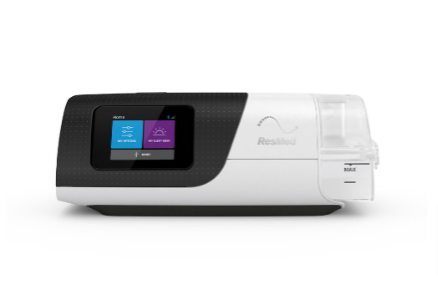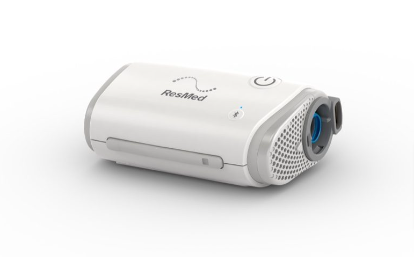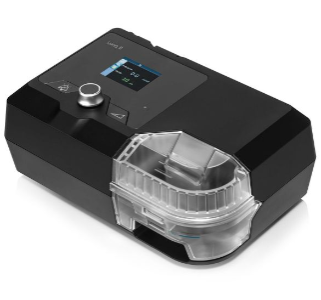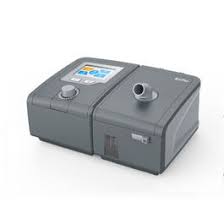Sleep apnea is a sleep disorder in which a person’s breathing starts and stops throughout the night. It affects about 30 million people1 in the United States, but only about six million are formally diagnosed.
One of the most common treatment recommendations for sleep apnea is CPAP therapy. A CPAP machine, or a continuous positive airway pressure2 machine, keeps the airway open throughout the night so that it won’t collapse and interrupt your breathing. CPAP therapy has been shown to reduce the risk of sleep apnea complications, from daytime fatigue to heart disease and stroke.2
If you snore loudly and regularly, wake up with a dry mouth or headache, experience daytime fatigue, or your partner notices pauses in your breathing at night, you might have sleep apnea and should talk to your doctor.2 To purchase one of these CPAP machines or any of their components, you’ll need a formal diagnosis from your doctor and a prescription for CPAP therapy.
Best CPAP Machines
- ResMed AirSense 11 – Editor’s Pick
- ResMed AirMini Portable – Best CPAP Machine for Travel
- 3B Luna II Auto CPAP Machine – Best CPAP Machine Features
- OxyGO ResPlus Auto CPAP Machine – Best Value CPAP Machine
Advice from a Medical Expert
We reached out to Dr. Raj Dasgupta, who has over 20 years of experience in the medical field, to see his thoughts on the most important features people should look for in a CPAP machine.
“When you’re picking out a CPAP machine, make sure it lets you adjust the pressure to fit your needs and has a heated humidifier and adjustable straps. Look for one that runs quietly too, so it won’t disturb your sleep or your partner’s. Consider features like data tracking, portability, and mask compatibility to make sure it’s the right fit for you.”
ResMed AirSense 11 – Editor’s Pick
ResMed AirSense 11 CPAP Machine
The ResMed AirSense 11 has a modern and sleek design with an easy-to-use touchscreen. The CPAP machine has a built-in heated humidifier and multiple other features to help you sleep better.
Why the ResMed AirSense 11 Earned Editor’s Pick
CPAP therapy can be difficult to get used to at first, but ResMed has taken this into consideration when designing the AirSense 11. This machine includes access to ResMed’s easy-to-navigate online support program and app, myAir™. This app is designed specifically to help people get used to CPAP therapy.
The design of the machine itself is modern and sleek, so it shouldn’t be an eyesore in the bedroom, and the interface is a simple-to-use touchscreen.
This CPAP includes a built-in heated humidifier to help prevent nasal congestion and sore throat, as well as an AutoRamp feature. This AutoRamp feature will allow you to start with a low airflow at the beginning of the night and ramp up to your prescribed setting, to help you fall asleep more soundly.
Our Take: We appreciate that this CPAP machine looks and feels more like a cool tech gadget than a medical device, making it a great choice for those who feel comfortable using things like apps, smartphones, and touchscreens. It also has some advanced comfort features you won’t find in other CPAP machines.
What We Liked
- Three models – The AirSense 11 comes in three model options: AutoSet, CPAP, or Elite. This gives you more variety in your selection.
- The technology – This machine comes with a touchscreen interface, as well as access to myAir, an app that guides you on how to start CPAP therapy and stick with it.
- Heated humidifier – The warm, humid air should feel smoother and easier to breathe, which should lead to less congestion than a CPAP without a humidifier. You can control it manually or automatically.
- AutoRamp option – This allows you to start your pressure at a lower setting while you’re falling asleep, and then it will automatically ramp up as the night progresses.
- Expiratory Pressure Relief (for AutoSet model) – This feature maintains regular airflow pressure while you inhale and reduces pressure when you exhale, so breathing out should feel easier.
Potential Drawbacks
- More tech-oriented than some – This machine is more tech-oriented than some other machines, so if you don’t love touchscreens and you won’t use the app, it may not be as good a fit for you.
- More expensive than others – This CPAP device is more expensive than some other devices, but if you have insurance, it should help cover your costs.
Customer Reviews of The ResMed AirSense 11
The ResMed Shop, which manufactures the ResMed AirSense 11, is rated 4.4 out of 5 stars on Trustpilot. The ResMed AirSense 11 offers advanced sleep tracking features for enhanced patient care, but some customers may find its high price point to be a drawback.
ResMed AirMini Portable – Best CPAP Machine for Travel
ResMed AirMini Portable CPAP Machine
This small and lightweight CPAP machine is an excellent choice for travel. It has a humidifier and a Smart Start and Stop feature that turns it on and off automatically.
Why the ResMed AirMini Portable Earned Best CPAP Machine for Travel
This lightweight and compact CPAP machine is ideal for those who need a portable solution for CPAP therapy. After all, just because you’re traveling doesn’t mean you can take a break from CPAP treatment. Generally, people will have a standard home CPAP device, and the travel CPAP is something more compact to bring along on trips. If you’re curious about whether you could use a travel CPAP full-time, we strongly recommend talking with your healthcare provider.
The ResMed AirMini is essentially a smaller, more compact, and simplified version of the ResMed AirSense. This machine won’t have the touchscreen or advanced technology, but it does have a humidifier (a much more compact humidifier) as well as an option for AutoRamp. Plus, it still has the ability to track your compliance and store your sleep data for up to 30 days.
The AirMini uses a Smart Start and Stop feature, which will automatically start when you put the mask on and then automatically stop when you take the mask off.
Our Take: This CPAP machine is portable, compact, and light, making it a great option for travel.
What We Liked
- Approved for in-flight use – This portable machine is approved by the Federal Aviation Administration for in-flight use. This should provide peace of mind ahead of any trips. This machine does not come with a battery though, so you must be able to plug it into a power outlet on your plane or at your destination.
- It comes with a travel bag – This CPAP comes with a drawstring travel bag, making it even more convenient for traveling.
- Waterless humidifier – This machine has the benefits of a humidifier, but without a water tank, the machine can be more compact and light for travel.
- AirMini App – You can use this app to access your sleep data. Plus, medical providers can adjust your settings via the app, if necessary.
- Smart start and stop – If you have to get up in the middle of the night, your CPAP machine will stop as soon as you take off your mask and start up as soon as you put it back on.
Potential Drawbacks
- Expensive – Some portable machines are less expensive than at-home CPAP machines. However, the ResMed AirMini costs about the same price as an at-home device.
- Not usually covered by insurance – Because this machine is seen as a “portable” device and possibly not a primary device, it may not be covered by your insurance.
- Not battery-operable – Even though this device is portable, you still must be able to plug it into a power outlet to use it. If you plan to use your CPAP mid-flight, verify beforehand that the aircraft provides power outlets for each seat.
- Louder than other machines – This portable device is slightly louder than some of ResMed’s other CPAP machines. If you’re a light sleeper, this could make it harder to doze off.
- Only compatible with certain masks – Given its size and portability, the AirMini is only compatible with certain ResMed masks.
Customer Reviews of the ResMed AirMini Portable
The ResMed AirMini Portable is rated 4.5 out of 5 stars based on customer reviews posted on Google. The ResMed AirMini Portable provides convenient and compact sleep therapy for customers on the go, yet some customers may perceive the limited humidification capability as a limitation.
3B Luna II Auto CPAP Machine – Best CPAP Machine Features
3B Luna II Auto CPAP Machine
The Luna II Auto CPAP machine allows you to choose between automatic and standard air pressure settings. It comes with multiple features, including an integrated heated humidifier, wifi, cellular data sharing, and automatic start and stop.
3B React Score
4.40 / 5
Why the 3B Luna II Earned Best CPAP Machine Features
You can use the Luna II Auto CPAP as either an APAP (automatic positive airway pressure) device or as a standard CPAP one. These different settings allow you to choose between air pressure that automatically adjusts to your breathing or one with a standard air pressure setting. This is unique because often you’ll have to either buy a CPAP or APAP device, but this machine gives you both in one.
The Luna II also includes an integrated heated humidifier, automatic start and stop, wifi and cellular data sharing, a 60-minute ramp time, and expiratory pressure relief (for easier exhaling).
Our Take: The 3B Luna II CPAP is a great option for those who love a bevy of features and versatility. Plus, when you consider this machine can either be used as an APAP or CPAP, the price is very reasonable.
What We Liked
- Expiratory pressure relief – This feature allows for easier exhaling while using the machine. Simply turn it on, and the machine will automatically decrease the air pressure when you are breathing out.
- 60-minute ramp up – With this feature, you can have the machine start with a lower air pressure while you are just going to sleep. After a set amount of time, the machine will gradually increase to your prescribed air pressure setting. This should make drifting off easier.
- Automatic start – As soon as you put on your CPAP mask, this machine will automatically start working, so you won’t need to fumble with it in the dark.
- Mask leak detection – This feature allows the machine to know if your mask is leaking. If it is, the machine will alert the sleeper so your mask can be adjusted.
Potential Drawbacks
- Slightly bulkier and heavier – This is probably not your best bet as a travel machine. It is slightly heavier and takes up more space than other CPAP devices.
- Not compatible with heated tubing – Even though the Luna II is compatible with all mask types and all standard tubing, it is not compatible with heated tubing. This can be a downside because heated tubing could help with nasal congestion and dry mouth.
- Louder than some other APAPs – With a sound level of 28 decibels, the Luna II is just slightly louder than the average APAP machine. Those who are sound-sensitive may prefer a quieter device.
- Data is less accessible – The data that this machine provides is structured more like a doctor’s report than the more visual information provided by some comparable machines.
Customer Reviews of The 3B Luna II Auto CPAP Machine
3B Medical, which manufactures the 3B Luna II Auto CPAP Machine is rated 4.5 out of 5 stars on Trustpilot. The 3B Luna II Auto CPAP Machine offers a user-friendly interface and advanced therapy features, but some customers may be disappointed by the machine’s relatively louder operational noise.
OxyGO ResPlus Auto CPAP Machine – Best Value CPAP Machine
OxyGO ResPlus Auto CPAP Machine
The OxYGO ResPlus Auto works in two modes: CPAP and APAP. This gives you extra versatility on top of several features such as a built-in humidifier, ramp ability, and a compact design.
Why the OxyGO ResPlus Earned Best Value CPAP Machine
The OxYGO ResPlus Auto can be used in either CPAP or APAP mode, giving it the versatility of the Luna II without the higher price tag. In fact, this CPAP is the most budget-friendly option on our list.
Even with the lower price tag, the OxyGO ResPlus Auto still includes a built-in humidifier, an easy and user-friendly interface, and ramp ability. It’s also compact and light enough for use at home and while traveling.
Even with all of these features, it is simple to use, featuring a more basic design with fewer bells and whistles.
Our Take: Considering this machine can function as both a CPAP and an APAP (which are typically much more expensive), the price is a very good deal. It may look more basic than the ResMed AirSense, but it certainly does the job.
What We Liked
- Ramp – If you’d like, you can set this CPAP device to ramp up to your prescribed air pressure level, between zero and 60 minutes after you put on your mask. This might allow you to fall asleep more easily.
- Important alerts – This CPAP will alert you if there are any issues with the power, humidifier, voltage, mask leakage, or an airway block, or if the TF card is full.
- CPAP or APAP – You can choose between a continuous amount of air pressure throughout the night, or an automatic amount of air pressure, which will adjust according to how you’re breathing in at the moment.
- Automatic start and stop – You can program this machine to start automatically when you begin breathing into your mask and stop once you stop breathing into the mask.
Potential Drawbacks
- Noisier than some other machines – If you are noise-sensitive, you might want to look for a machine that is specifically designed to be quiet.
- No temperature controls – While you can adjust the level of humidity in this machine, you can’t adjust its temperature.
- Not FAA approved – You can remove the humidifier on this machine to make it more compact for travel. However, this CPAP is not approved by the Federal Aviation Administration for in-flight use.
Customer Reviews of The OxyGO ResPlus Auto CPAP Machine
The OxyGO ResPlus Auto CPAP Machine provides portability and integrated oxygen therapy for customers, but some customers might find the machine’s higher price point to be a potential drawback.
How can a CPAP machine help with symptoms of obstructive sleep apnea?
“A CPAP machine works by blowing pressured air into your upper airway while you sleep, to help keep it open. This prevents interruptions in airflow, reduces snoring, and improves the quality of your sleep. Essentially, it makes sure you are able to breathe normally throughout the night, which can make a big difference in how you feel during the day.” – Dr. Raj Dasgupta
Different Types of CPAP Machines for Sleep Apnea
Positive airway pressure (PAP) therapy is a form of treatment for sleep apnea. When someone has obstructive sleep apnea3, they experience interruptions in breathing during sleep due to airway obstruction, and the temporary lapses in breathing may result in oxygen deprivation and microarousals from sleep.
PAP therapy works by delivering pressure-based airflow through a ventilation system to help ensure the sleeper gets enough oxygen throughout the night. Sometimes CPAP is used as a general term for these devices. However, CPAP machines are actually a specific type of positive airway pressure device, and there are other types of these devices available as well.
Your healthcare provider will tell you the best type of PAP device for your sleep apnea.
CPAP
CPAP stands for “continuous positive airway pressure” because the CPAP machine provides the same amount of air pressure the whole time it is working. This continuous air pressure pushes the airway open via a tube and a mask to help prevent pauses in breathing for those with sleep apnea.
CPAP machines are different from APAP and BiPAP since those others provide a varying amount of air pressure throughout the night. You can think of a CPAP as the simplest or most basic of the three types of PAP devices.
Related: Best CPAP Alternatives
APAP
APAP stands for “automatic positive airway pressure.” Like CPAPs, they are used by those with sleep apnea to keep the airways open. In fact, they look just like CPAPs, made up of a machine, a hose, headgear, and a mask. However, rather than provide one continuous amount of air pressure, APAP machines adjust automatically within a set pressure range.
Your sleep specialist or doctor will prescribe the recommended lowest and highest pressure you’ll need, and then according to how you’re breathing, the machine will set the pressure within that range. It does this with technology that detects an airway closure and then increases the pressure to re-open the airway. This offers the sleeper greater flexibility.
Since APAP machines are more complex than CPAPs, they tend to be more expensive.
Learn More: APAP Machine vs. CPAP Machine
BiPAP
BiPAP stands for “bilevel positive airway pressure.” Just like CPAP and APAP machines, these are used by those with sleep apnea to keep the airways open. They look just like CPAPs and APAPs as well.
The difference is that BiPAPs have two pressure settings: one for when you’re breathing in and one for when you’re breathing out. This tends to make exhaling a bit easier, especially for those who have high-pressure settings.
Explore our picks for the best BiPAP machines here.
Travel
A travel CPAP is usually a smaller and lighter-weight machine that is more portable, which makes it better for traveling than a regular at-home setup. Many travel CPAPs are approved for in-flight operation by the Federal Aviation Administration4. Some travel CPAPs also have the option to be battery-operable. If you need a CPAP that can run without electricity for the night, just be sure to check for this option.
What Are the Different Parts of a CPAP Machine?
| Item | Description |
|---|---|
| Connective Hose | The connective hose links the CPAP mask and the machine together. The standard size is 6 feet long, but tubing is available in 6, 8, and 10-foot lengths. Most tubing is universal and will fit on any model. |
| Airflow Generator | The generator powers the CPAP machine and is housed in a small box with a motorized fan inside. The fan pulls in air from the room, pressurizes it, and then delivers it through a mask or nasal cannula. Most devices have a built-in feature that allows certain settings to be customized depending on each individual’s needs. Some even have automatic pressure adjustments that will deliver the lowest levels possible to keep you comfortable while still providing optimal therapy. |
| Filter | CPAP machines require a filter to eliminate allergens and impurities in the air like smoke and dust. Similar to air filters in your home or car, these are designed to improve the quality of the air being used in CPAP therapy and keep harmful contaminants out. Disposable filters should be replaced every four weeks or when they start to show discoloration. Reusable filters are designed to be cleaned and reused for longer periods, extending up to six months before being replaced. |
| Humidifier | The humidifier is usually built into the box, although some models feature humidifiers that can be removed. The humidifier warms the pressurized air before delivering it through a small hose. Humidification is usually optional but can be helpful for those who live in dry climates. Using a humidifier can also alleviate discomfort for users who wake up with a dry mouth, nasal passages, or throat. |
CPAP Machine Accessories
| Item | Description |
|---|---|
| Mask | The CPAP mask fits over the nose (nasal and nasal pillow masks), mouth (hybrid masks), or both the nose and mouth (full-face masks). The mask is connected to the hose to deliver air pressure from the CPAP machine. |
| Cushion | The mask cushion attaches to the mask, allowing it to sit comfortably and be snug against the face. The mask cushion should prevent sores and indentations on the face, as well as prevent air leaks. |
| Headgear | Headgear is necessary to keep the mask securely attached to the face during sleep. Headgear can be simple or elaborate, depending on the weight of your mask. Usually, headgear is made out of fabric or silicone and is adjustable. Most headgear can also be easily removed using buckles, clips, magnets, etc. |
| Battery | Some portable CPAP machines will have the option of being battery-operable. In these cases, they will come with a rechargeable battery. |
| Hose Holder | A CPAP hose holder is an accessory that can help keep your CPAP hose elevated or otherwise out of the way and untangled while you sleep. Hose holders can attach to the wall or clamp to a headboard or bedside table. |
| Travel Case | Portable CPAP machines often come with a travel case, to make it easier to carry them and potentially use them in flight. |
What to Look for in a CPAP Machine
Price
CPAP machines range in price, but most models are between $200 and $800 depending on the features that are included. BiPAP machines are more expensive and may be over $1,000. Some models come with everything you need, and others require the purchase of a mask separately.
More Information: The Cost of CPAP Machines and Does Insurance Cover CPAP Machines?
Warranty
Warranties are usually offered through the manufacturer and typically range from two to five years. The warranty covers any defects due to faulty materials or workmanship, and most companies will either repair or replace the broken parts.
Type of Mask
Masks are sold separately from the machine and come in various shapes and sizes to accommodate the user’s preference. The four main categories of masks include:
- Nasal – Nasal CPAP masks are helpful for nose breathers. These masks are smaller than full face masks and are designed to fit snugly over just the nose, from the bridge to the upper lip. The concentrated airflow through the nasal passages allows for a greater amount of pressure for individuals who require higher settings.
- Nasal Pillow – Nasal pillow masks are the smallest, most compact option. They deliver airflow through both nostrils, allowing for greater pressure. With a nasal pillow mask, two small pillows are inserted into the nostrils rather than surrounding them. Nasal pillow masks are suitable for users who breathe through their nose and prefer the freedom to move around in their sleep.
- Full Face – Unlike nasal masks, full face CPAP masks cover the entire mouth and nose, creating a seal over both airways. These masks are ideal for users who breathe through their mouth, are experiencing nasal congestion, or require high-pressure settings. These masks are not always ideal for side or stomach sleepers since they can more easily become displaced, though this also depends on the particular model.
- Hybrid – Hybrid CPAP masks are a great alternative if you need something that helps with breathing through the nose and mouth but isn’t as bulky as a full face mask. Hybrid CPAP masks will typically cover the mouth but rather than covering the nose, they’ll feature nasal pillows (similar to the design of a nasal pillow mask).
To see our top picks, check out our roundup for the best CPAP masks.
Machine and Mask Size
CPAP devices come in a range of shapes and sizes, some being lightweight and compact for travel.
If bedroom space is limited, a smaller machine may be preferable. Even the largest machines, though, can usually fit on a bedside table or dresser.
Additionally, if you are a woman looking for a CPAP mask, or exploring CPAP masks for children, there are size and functional elements to consider.
Pressure Range
The optimal pressure range is usually set by a physician depending on each individual’s needs but generally falls between 6 and 14 cmH20. Most of the available models on the market deliver a wide range of pressure with airflow ranging between 4 to 20 cmH20.
Humidifier
The humidifier may be built-in or detachable, but both require water to function. Built-in humidifiers will need water to be poured into a chamber in the unit while removable humidifiers can be filled separately. The size of the chamber will also determine how long the machine can operate before requiring more water.
Ramp Time
Once the machine is turned on, it takes a while to reach the prescribed airflow pressure settings. This time, referred to as ramp time, is often between 30-60 minutes. Starting at a lower setting may make it easier to fall asleep for some users.
Hose Length
The connective tubing between the mask and the CPAP device determines how much space an individual has to move around. Most standard hoses are 6 feet in length, but longer hoses are available and can be used with any machine.
Volume
The sound a CPAP makes is measured in A-weighted decibels, or dbAs, which describe the relative volume of air-based noises. Most machines are around 30 dbAs, compared to snoring which is anywhere from 60-90 dbAs. The sound may take some time to get used to, but most people find it quickly becomes background noise.
Operating Altitude
Unless you plan on climbing Mount Everest or live high up on a mountain, altitude probably won’t be an issue. Most machines are designed to function at normal altitudes and may not work properly outside of this range. If you require a device that can withstand higher altitudes, check the settings and look for travel CPAPs that often have this added feature.
Power Source
Most machines are electric and can be easily plugged into an outlet. Models will usually function on a voltage range between 100 to 240V AC. If you plan on traveling with your unit, be sure to check voltage compatibility or look for a device that can function on batteries just in case.
Alerts
Most models feature built-in monitoring that will alert users if there is a problem such as a power failure, an air pressure leak, or if the seal is broken on the mask. Alerts may be audible similar to an alarm or may be seen on a built-in LCD screen.
Controls
Every machine will have controls that allow users to turn the machine on/off and adjust the various settings. Some also feature automatic controls that adjust the amount of pressure based on the user’s breathing and whether they are asleep or awake.
Sleep Data
Many machines now offer advanced features with data monitoring and recording that can be viewed on the machine and sent electronically to a computer or smart device. This allows users to track their progress and send this data to a healthcare provider as well.
Maintenance
Due to the frequency with which you use CPAP machines, keeping them clean from bacteria and fungus is critical for your health and safety. Cleaning your CPAP machine is fairly easy. You can learn more about how to clean a CPAP here.
CPAP Recalls
It’s also important to be on the lookout for any recalls associated with a particular CPAP machine. For example, in June 2021, Philips Respironics issued a voluntary recall5 of millions of their products, including CPAP machines, BiPAPs, and ventilators.
The reason behind the recall was a specific type of polyurethane foam used in all of these devices in an attempt to reduce these machines’ noise levels. It was later found that this particular foam could break apart and be inhaled or ingested6, causing a myriad of health issues in users.
Below is a complete list7 of all of the Philips products that have been recalled at this point, including CPAPs, BiPAPs, and ventilators.
- Aeris
- A-Series BiPAP A30
- A-Series BiPAP A40 (ventilator)
- A-Series BiPAP Hybrid A307
- A-Series BiPAP V30 Auto (ventilator)
- C-Series ASV
- C-Series S/T and AVAPS
- Dorma 400, 500, Auto
- DreamStation ASV, Go, ST, Auto, and AVAPS
- DreamStation Auto
- E30
- FR REP DreamStation Auto BiPAP, DOM-RECRT
- Garbin Plus
- LifeVent
- OmniLab Advanced Plus
- REMstar SE Auto
- REP DreamStation Auto CPAP, DOM-RECERT
- REP DreamStation Auto CPAP Recert
- SystemOne ASV4, Q-Series, 50 series and 60 series
- Trilogy 100
- Trilogy 200
- Trilogy Evo ventilators
How to Use a CPAP Machine
Before using a new machine for the first time, read over the instructions or watch the instructional videos that many companies offer. It is important to familiarize yourself with all of the functions and features your device offers. While every model will be slightly different, here are some basic step-by-step instructions that should apply to most machines:
- Choose a level surface for the machine that is close to your bed and where there is little risk of falling.
- Plug the machine into an electrical outlet or insert the required battery.
- Ensure the humidifier chamber is filled with distilled water.
- Connect the appropriate tubing between the machine, humidifier, and mask.
- Adjust the mask to find a comfortable, secure fit without any leaks.
- Turn the machine on and adjust the settings.
- Monitor progress and data over time.
If you want to know more about CPAP masks, check out our guide on how to sleep better with a CPAP mask.
Additional Sleep Apnea Considerations
Adjustable Bed Frame
An adjustable bed frame allows sleepers to elevate the head of the bed and sometimes the feet too. Sleeping with the head at an incline may help to minimize snoring by keeping the airways more open. Many adjustable beds come with a preset “anti-snore” setting that places the head at an optimal angle.
Sleep Position
Sleeping on the back is considered the worst position for sleep apnea8. In this position, the esophagus constricts and the tongue falls back into the throat making apnea worse.
Conversely, sleeping on the side or stomach allows the airways to remain open and clear, improving sleep apnea symptoms like snoring.8 That said, stomach and side sleeping may not be as easy with certain CPAP masks.
Explore our picks for the best side sleeper mattress and the best mattress for stomach sleepers.
Choosing the Right Pillow
Similar to your sleeping position and using an adjustable bed frame, a pillow designed for sleep apnea can also help to minimize symptoms. The height of the pillow is referred to as the “pillow loft.” For back sleepers, having a thicker pillow loft may improve breathing by elevating the head and keeping the airway open.
Side sleepers will be most comfortable with a pillow that best supports the head and maintains a neutral spine. If a pillow is too low or too high, the neck will be hyper-extended which could impair breathing. For more, see our roundup of the best pillows for side sleepers.
Frequently Asked Questions
How much does a CPAP machine cost?
The cost of your CPAP machine will depend on whether or not you’re using insurance to help pay for it. On average, without any insurance, the cost of a CPAP is about $800 dollars. However, it could be more or less, depending on the machine you choose and what your insurance covers.
What does a CPAP machine do?
A CPAP machine is used by those with sleep apnea to keep the airways open during sleep. It does this by providing a continuous amount of air pressure, via a mask, into the nostrils and/or mouth. This air pressure keeps the airways open and allows those with sleep apnea to breathe without pausing.2
What are the benefits of using a CPAP machine?
When used consistently, CPAP machines can help reduce the risks of untreated sleep apnea.2 These risks include daytime fatigue, high blood pressure or heart problems, type 2 diabetes, complications with certain medicines or surgeries, metabolic syndrome, and liver problems.3
What are the side effects of using a CPAP machine?
Some of the most commonly reported side effects of using a CPAP machine9 include leaky mask, dry mouth, nasal congestion, feeling claustrophobic, skin irritation, and difficulty falling asleep.

Natalie Grigson
Writer
About Author
Natalie is a content writer for Sleep Advisor with a deep passion for all things health and a fascination with the mysterious activity that is sleep. Outside of writing about sleep, she is a bestselling author, improviser, and creative writing teacher based out of Austin.
Combination Sleeper
References:
- Berg, Sara. “What doctors wish patients knew about sleep apnea”. American Academy of Sleep Medicine. 2022.
- “CPAP Machine”. Cleveland Clinic. Last modified November 9, 2021.
- “Sleep Apnea”. Mayo Clinic. Last modified April 6, 2023.
- “Guide for Aviation Medical Examiners”. Federal Aviation Administration. Last modified October 25, 2023.
- “UPDATE: Certain Philips Respironics Ventilators, BiPAP Machines, and CPAP Machines Recalled Due to Potential Health Risks: FDA Safety Communication”. U.S. Food & Drug Administration. Last modified June 2, 2023.
- “Philips issues Dreamstation CPAP recall notification”. American Academy of Sleep Medicine. Last modified December 7, 2021.
- Llamas, Michelle. “Philips CPAP Recall”. Drugwatch.com. Webpage accessed December 12, 2023.
- “Choosing the Best Sleep Position”. Johns Hopkins Medicine. Webpage accessed December 12, 2023.
- “CPAP machines: Tips for avoiding 10 common problems”. Mayo Clinic. Last modified November 29, 2023.




